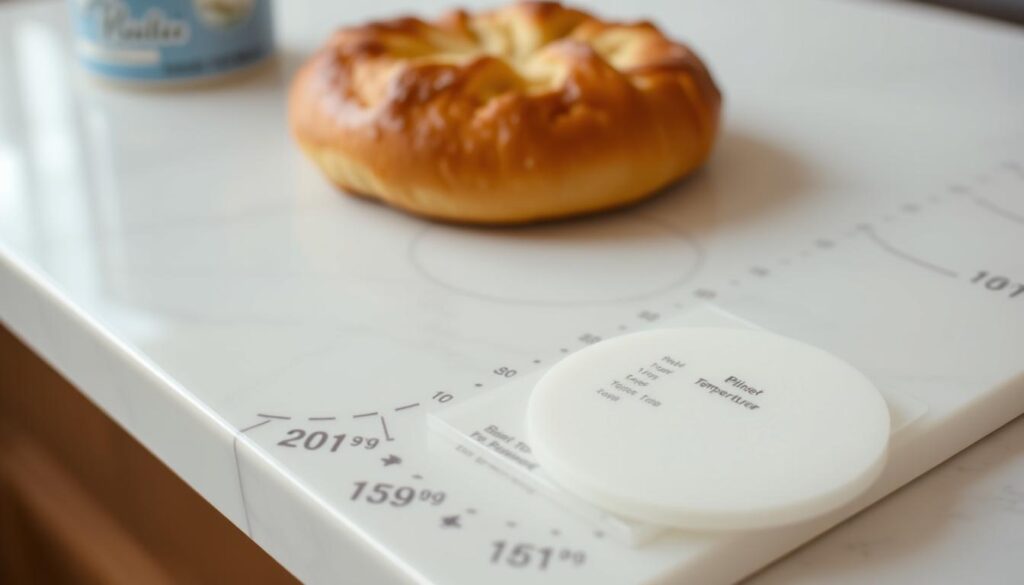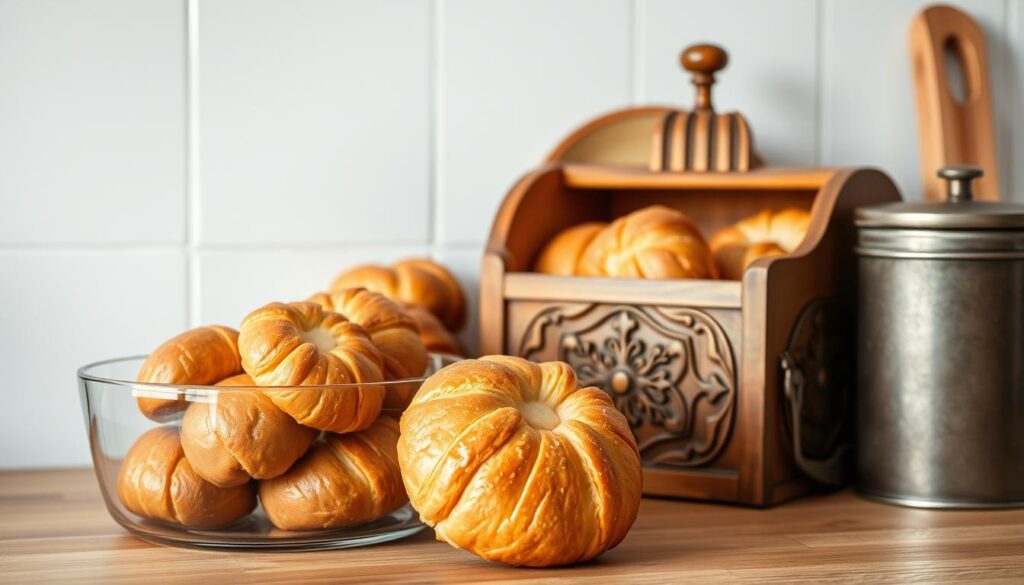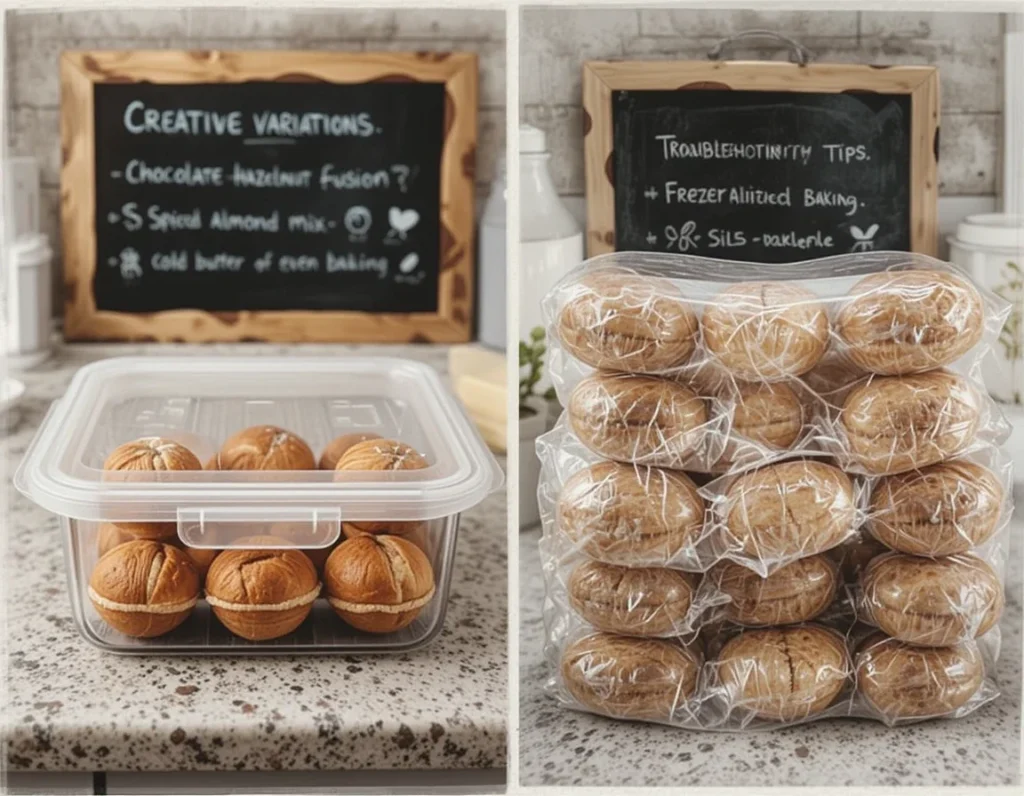Discover how to make professional Swiss pastry at home! The nussgipfel recipe opens the door to authentic European baking. These flaky croissants turn simple ingredients into amazing treats.
Making perfect nussgipfel needs precision and skill. Each pastry shares a piece of Swiss baking history. It combines buttery layers with rich nutty fillings that melt in your mouth. Whether you’re an experienced baker or just starting, mastering this Swiss pastry will take your baking to new heights.
Picture pulling golden-brown, crisp croissants from your oven. They’re filled with aromatic nuts and have layers so delicate they seem to float. Our step-by-step guide will teach you professional techniques for perfect results every time.
Get ready to wow your friends and family with a nussgipfel recipe that shows off Swiss culinary skill. Your baking journey begins now!
Understanding Swiss Pastry Excellence: The Art of Nussgipfel
Explore the world of Swiss pastry tradition and discover the nussgipfel. This crescent-shaped treat is more than a snack. It’s a piece of authentic Swiss baking history.
The nussgipfel’s history is filled with cultural importance. It started in Eastern Switzerland in the early 20th century. These pastries became a favorite, even during hard times like World War I.
Traditional Swiss Origins
Nussgipfel is rooted in Swiss culinary traditions. It has different versions across regions. Important moments include:
- Early 1920s: Almond variants appeared in the Romandie region
- 1930s: Hazelnut filling documented in German-speaking Switzerland
- 1940s: Standardized recipes published in professional baking guides
What Makes a Perfect Nussgipfel
Making a great nussgipfel takes skill and love. The perfect pastry has:
- Flaky, delicate layers
- Rich, nutty filling
- Golden-brown exterior
- Balanced sweetness
Cultural Significance in Swiss Bakeries
Nussgipfel is more than a pastry; it’s a tradition. Alpine hikers and city folks love these treats in Swiss bakeries. From Zurich to Lucerne, nussgipfel shows Swiss baking skill.
A taste of nussgipfel is a journey through Swiss baking heritage.
Essential Ingredients for Authentic Nussgipfel
Making a real Swiss pastry needs the right nussgipfel ingredients. These ingredients mix traditional tastes and textures. They turn a simple recipe into a tasty Swiss treat that takes you to the Alps.
Your main Swiss pastry parts for nussgipfel are:
- Puff pastry – High-fat European-style butter with 82% fat content
- Ground nuts (hazelnuts or almonds)
- Apricot jam for sweetness
- Fresh milk
- Lemon zest for brightness
- Ground cinnamon
The nut filling is key for the special flavor. Pick fresh, top-notch almonds or hazelnuts. Ground nuts should be finely ground for a smooth, rich filling that blends well with the pastry.
Experts say to mix bread flour and all-purpose flour. Use about 70% bread flour and 30% all-purpose flour. This mix gives your nussgipfel the best texture and structure.
Pro tip: Always use fresh, high-quality ingredients to elevate your Swiss pastry from good to extraordinary!
Temperature and precision matter when using these ingredients. Chill your dough for 2 hours or overnight. This makes the dough easier to handle and adds to the flaky texture that makes nussgipfel so tempting.
The Secret Behind Perfect Puff Pastry Layers
Making flaky, delicate pastry is an art that needs precision and knowledge of puff pastry techniques. The secret to a perfect Nussgipfel is mastering the lamination process. This turns simple ingredients into a luxurious, multilayered treat.
To make bakery-quality puff pastry, focus on two key things: temperature control and proper folding. Your success depends on keeping the right conditions during preparation.
Temperature Control Techniques
Keeping the temperature just right is key to flaky pastry tips. Remember these important points:
- Use European-style butter with at least 82% butterfat
- Keep butter temperature between 55-65°F for best layering
- Chill dough between folding sessions for 20-30 minutes
- Work in a cool kitchen environment
Lamination Process Explained
The lamination process involves folding and rolling butter into the dough to create thin layers. Your goal is to create at least three distinct fold cycles. This will give you the flaky texture you want.
Common Pastry Mistakes to Avoid
To avoid tough or soggy pastry, avoid these mistakes:
- Don’t overwork the dough
- Use cold butter, not room temperature
- Don’t skip resting periods
- Roll dough too thick (aim for 1/8-inch thickness)
By mastering these puff pastry techniques, your Nussgipfel will go from good to extraordinary. You’ll get a professional-quality result every time.
Mastering the Nutty Filling
Making the perfect nussgipfel filling is an art. It turns a simple pastry into a Swiss culinary gem. The filling needs the right ingredients for that rich, nutty taste that makes nussgipfel unforgettable.
Start your nut paste recipe with top-notch nuts. Use ground hazelnuts, almonds, or walnuts for the base. Lightly toasting the nuts brings out their flavors and adds depth to your Swiss pastry filling.
- Toast nuts until golden brown and fragrant
- Grind nuts to a fine, consistent texture
- Mix with traditional Swiss ingredients like:
- • Apricot jam
- • Milk
- • Lemon zest
- • A pinch of cinnamon
Professional bakers say your nussgipfel filling should be smooth and spreadable. The right mix is ground nuts with just enough liquid. This makes a paste that’s not too dry or too wet.
Try mixing different nuts to make your filling unique. Some like just hazelnuts, while others mix almonds and walnuts for a richer taste. The aim is to match the filling with the pastry’s light, flaky layers.
Pro tip: Always cool your nut mixture completely before spreading it on the pastry to prevent soggy layers.
Step-by-Step Assembly Guide
Making the perfect nussgipfel needs precision and passion. Learning how to assemble it turns a simple pastry into a Swiss culinary gem. Your journey to making flaky, nutty treats begins with mastering pastry shaping techniques.
Rolling and Shaping Techniques
Croissant rolling is an art that requires focus. Start by rolling out your puff pastry to a ¼ inch thickness. Use a sharp knife or pastry wheel to cut triangular shapes with a base width of 3-4 inches.
- Roll pastry on a lightly floured surface
- Maintain consistent dough thickness
- Cut triangles with clean, precise edges
Filling Distribution Tips
Even filling ensures each bite is full of flavor. Spread your nutty mixture carefully, leaving small margins at the edges. This prevents leakage during baking.
| Filling Technique | Recommended Amount |
|---|---|
| Spread from base to tip | 1-2 tablespoons |
| Avoid overfilling | Leave 1/2 inch border |
Sealing Methods for Perfect Results
Proper sealing keeps the filling inside and the pastry’s shape intact. Gently press edges with your fingertips or use a fork to create a decorative crimp.
- Fold triangle’s corners inward
- Roll from base to tip
- Pinch edges to seal
Your nussgipfel assembly is complete when each pastry looks uniform and tightly sealed. With practice, you’ll make bakery-worthy treats in your kitchen.
Baking Temperature and Timing Strategies

Getting the right pastry oven temperature is key for golden, flaky nussgipfel. Your baking tips start with knowing the exact temperature and timing. This turns raw dough into a tasty pastry.
Experts say to set your oven to 375°F (190°C) for the best results. This temperature helps your nussgipfel get a golden-brown outside and a soft inside. The baking time guide suggests 15-18 minutes for perfect doneness.
- Preheat your oven completely before placing the pastries inside
- Ensure your oven heats correctly by placing an oven thermometer inside and comparing its reading to the set temperature.
- Place nussgipfel on a middle rack for even heat distribution
- Flip the baking sheet around halfway through cooking to promote even browning.
Visual cues are key to knowing when your nussgipfel are done. Look for a uniform golden-brown color and a crisp, flaky exterior. Slight variations in individual ovens mean you might need to adjust timing slightly.
Pro tip: If baking multiple batches, let your baking sheet cool between uses. This prevents uneven heating. A well-prepared baking surface helps you get consistent, professional-quality nussgipfel every time.
Creating the Perfect Glaze and Finish
The final touch of your nussgipfel can turn a good pastry into an amazing culinary experience. Mastering nussgipfel glaze and pastry finishing techniques needs precision and creativity.
Your glaze is the crowning glory of these delicate Swiss pastries. The traditional approach involves creating a smooth, glossy coating. This coating enhances both flavor and visual appeal.
Glaze Consistency Secrets
Achieving the perfect nussgipfel glaze demands attention to detail. Here are key tips for a flawless finish:
- Use fresh lemon juice for bright, zesty flavor
- Sift powdered sugar to prevent lumps
- Gradually add liquid for ideal thickness
- Aim for a consistency that drips slowly but evenly
Exploring Nut Topping Variations
Nut toppings add crunch and visual interest to your nussgipfel. Consider these delightful options:
| Nut Variety | Flavor Profile | Recommended Quantity |
|---|---|---|
| Flaked Almonds | Light, delicate | 2-3 tablespoons |
| Chopped Hazelnuts | Rich, robust | 1/4 cup |
| Toasted Walnuts | Earthy, deep | 3-4 tablespoons |
Pro tip: Toast your nuts briefly to enhance their natural flavors before sprinkling them over the glaze. This simple step elevates your pastry finishing techniques from good to extraordinary.
The secret to a perfect nussgipfel is in the details – a precise glaze and carefully chosen nut topping can make all the difference.
Storage and Freshness Tips

Keeping nussgipfel fresh is key. They need special care to stay crisp and tasty. Your baked pastries are worth it.
For a short time, store nussgipfel in an airtight container at room temperature. They stay fresh for up to 2 days. This way, you can enjoy them soon after baking.
Freezing and Long-Term Preservation
Freezing is great for keeping nussgipfel longer. Here’s how to freeze them:
- Wrap each pastry tightly in plastic wrap
- Put wrapped nussgipfel in a freezer-safe container
- Maintain in the freezer for as long as two months.
Reheating Techniques
Reheat frozen or chilled nussgipfel with these methods:
- Preheat your oven to 300°F
- Put pastries on a baking sheet
- Warm for 3-5 minutes until they’re crisp
- Let them cool for 1-2 minutes before eating
Good storage and reheating keep your Swiss bakery taste at home.
Variations and Creative Twists
Swiss pastry flavors open up a world of possibilities for nussgipfel variations. These changes can turn a classic treat into a new adventure. Traditional recipes are a good start, but adding creative fillings can make your baking even more exciting.
Exploring nussgipfel reveals many delightful twists beyond the classic recipe. Each twist adds its own special touch to this beloved Swiss pastry.
Hazelnut and Almond Flavor Profiles
When it comes to nut-based fillings, you have two main choices that change the pastry’s taste:
- Hazelnut: Rich, deep flavor with a slightly roasted undertone
- Almond: Lighter, more delicate taste with subtle sweetness
Modern Flavor Adaptations
Today’s bakers are trying new things with nussgipfel variations. Here are some exciting flavor mixes:
- Chocolate-hazelnut fusion
- Spiced almond with cinnamon
- Fruit-nut combinations like raspberry-almond
- Savory options with herb-infused nut fillings
Your nussgipfel can show off seasonal ingredients or local flavors. Feel free to try new things and make your own special version of this Swiss pastry classic.
Troubleshooting Common Issues

Nussgipfel troubleshooting can turn pastry problems into baking solutions. Every baker faces challenges, but knowing common issues helps make perfect Swiss pastries every time.
When making nussgipfel, several common problems can happen during baking. Spotting and fixing these issues fast ensures your pastries are flaky and tasty.
- Pastry Not Puffing Properly
- Make sure butter is cold when making layers
- Rest the dough between folding steps
- Check if your oven’s temperature is right
- Filling Leakage Prevention
- Seal the edges well
- Don’t overfill the pastry triangles
- Chill the pastries before baking
- Uneven Browning Challenges
- Rotate the baking sheet halfway
- Use light-colored baking sheets
- Check how evenly your oven heats
Professional bakers say practicing these solutions is key to mastering nussgipfel. Every try gets you closer to making perfect Swiss pastries.
Pro tip: Patience and precision are key to overcoming pastry problems!
Remember, consistent practice improves your nussgipfel troubleshooting skills. Don’t get discouraged by early failures—every great baker began where you are now.
Conclusion
Your journey in Swiss baking has given you the skills to make amazing nussgipfel. You now know how to make the flaky pastry and the nutty filling. With each try, you get closer to making it just like the Swiss bakeries.
Mastering nussgipfel takes time and practice. The skills you’ve learned, like controlling temperature and layering butter, can be used in many recipes. This means you can make delicious treats that connect you to Swiss traditions.
Keep trying new nuts and creative ideas to deepen your love for pastry making. Whether it’s for a special event or a tasty breakfast, your skills will wow everyone. Enjoy every step of making your nussgipfel and relish each bite.
Swiss baking is more than just recipes. It’s about passion, precision, and the joy of making something special. Keep practicing, stay curious, and let your love for baking show in every nussgipfel you make.
FAQ
What are the traditional nuts used in authentic Swiss nussgipfel?
Authentic Swiss nussgipfel use hazelnuts or almonds. These nuts are toasted and ground. This makes the pastry rich and aromatic.
How difficult is it to make nussgipfel at home?
Making nussgipfel at home is challenging but doable. It requires mastering puff pastry and controlling temperatures.
Can I make nussgipfel with alternative nuts or dietary restrictions?
Yes, you can try different nuts like walnuts or pecans. There are also gluten-free and vegan options. You can adjust ingredients for various diets while keeping the pastry’s essence.
How long do nussgipfel stay fresh?
Enjoy nussgipfel within 1-2 days for the best taste. Keep them at room temperature in a tightly sealed container for up to three days. Freeze for up to 2 weeks for longer storage.
What is the best way to reheat nussgipfel?
Reheat nussgipfel in a preheated oven at 350°F (175°C) for 5-7 minutes. Avoid microwaving to keep the pastry flaky.
Are nussgipfel similar to other pastries?
Nussgipfel are similar to other nut-filled pastries but are unique. They have a distinct Swiss shape and filling.
Can I prepare nussgipfel dough in advance?
You should make the dough and filling ahead of time. The dough can be refrigerated for up to 2 days or frozen for weeks.
What are common mistakes to avoid when making nussgipfel?
Avoid overworking the dough and using warm ingredients. Also, ensure consistent rolling and proper sealing. Cold temperatures and precise techniques are key.
How do I know when nussgipfel are perfectly baked?
Look for a golden-brown exterior and flaky texture. The pastry should be crisp outside and tender inside, with the filling warm but not burnt.
Can children help make nussgipfel?
Absolutely! Kids can help with measuring, mixing, and glazing under adult supervision. It’s a fun way to teach them about baking and Swiss traditions.